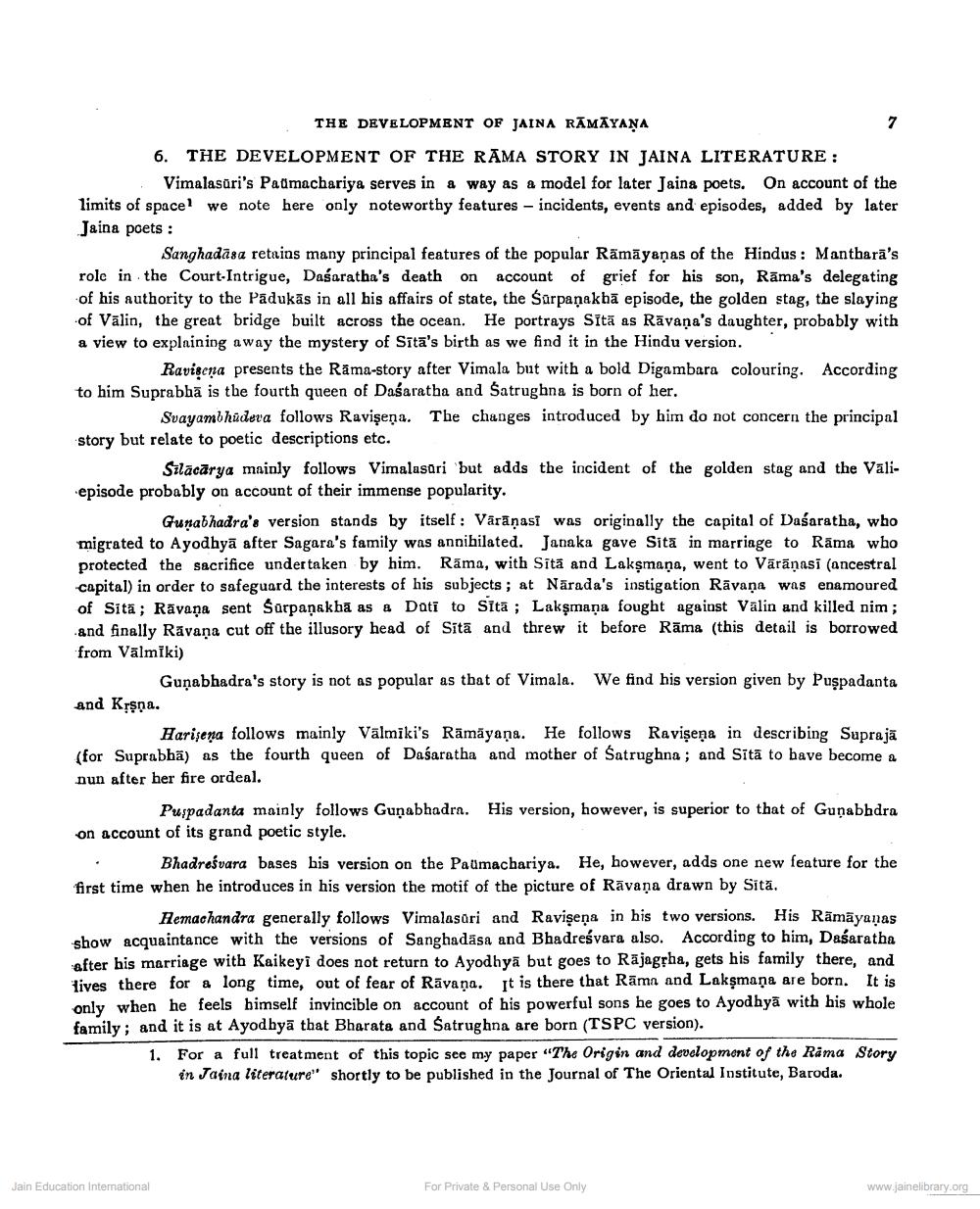________________
THE DEVELOPMENT OF JAINA RĀMAYAŅA
6. THE DEVELOPMENT OF THE RAMA STORY IN JAINA LITERATURE :
Vimalasuri's Padmachariya serves in a way as a model for later Jains poets. On account of the limits of space! we note here only noteworthy features - incidents, events and episodes, added by later Jaina poets :
Sanghadāsa retains many principal features of the popular Rāmāyaṇas of the Hindus: Manthara's role in the Court.Intrigue, Dasaratha's death on account of grief for his son, Rāma's delegating of his authority to the Padukās in all his affairs of state, the Śärpanakhā episode, the golden stag, the slaying of Vālin, the great bridge built across the ocean. He portrays Sītā as Rāvana's daughter, probably with a view to explaining away the mystery of Sīta's birth as we find it in the Hindu version.
Ravisena presents the Rāma-story after Vimala but with a bold Digambara colouring. According to him Suprabhā is the fourth queen of Daśaratha and Satrughna is born of her.
Svayambhudera follows Ravişeņa. The changes introduced by him do not concern the principal story but relate to poetic descriptions etc.
Silācārya mainly follows Vimalasäri but adds the incident of the golden stag and the Valiepisode probably on account of their immense popularity.
Gunabhadra's version stands by itself: Vārāṇasi was originally the capital of Dasaratha, who migrated to Ayodhyā after Sagara's family was annihilated. Janaka gave Sita in marriage to Rāma who protected the sacrifice undertaken by him. Rāma, with Sitã and Laksmana, went to Varanasi (ancestral capital) in order to safeguard the interests of his subjects; at Nārada's instigation Rāvana was enamoured of Sita: Ravana sent Sarpanakha as a Dati to Sītā ; Laksmana fought against Valin and killed nim; and finally Ravana cut off the illusory head of Sītā and threw it before Rāma (this detail is borrowed from Vālmiki)
Guņabhadra's story is not as popular as that of Vimala. We find his version given by Puşpadanta and Krşņa.
Harisena follows mainly Vālmīki's Rāmāyaṇa. He follows Ravişeņa in describing Suprajā (for Suprabhā) as the fourth queen of Daśaratha and mother of Satrughna ; and Sītā to bave become a nun after her fire ordeal.
Puspadanta mainly follows Gunabhadra. His version, however, is superior to that of Guņabhdra on account of its grand poetic style.
• Bhadreśvara bases his version on the Paumachariya. He, however, adds one new feature for the first time when he introduces in his version the motif of the picture of Rāvaņa drawn by Sită.
Remachandra generally follows Vimalasari and Ravişeņa in his two versions. His Rāmāyanas show acquaintance with the versions of Sanghadása and Bhadreśvara also. According to him, Dasaratha after his marriage with Kaikeyi does not return to Ayodhyā but goes to Rajagpha, gets his family there, and lives there for a long time, out of fear of Rāvana. It is there that Rāma and Lakşmaņa are born. It is only when he feels himself invincible on account of his powerful sons he goes to Ayodhyā with his whole family; and it is at Ayodhyā that Bharata and Satrughna are born (TSPC version).
1. For a full treatment of this topic see my paper "The Origin and development of the Rama Story
in Jaina literature" shortly to be published in the Journal of The Oriental Institute, Baroda.
Jain Education International
For Private & Personal Use Only
www.jainelibrary.org




